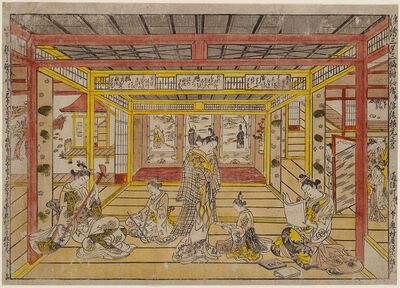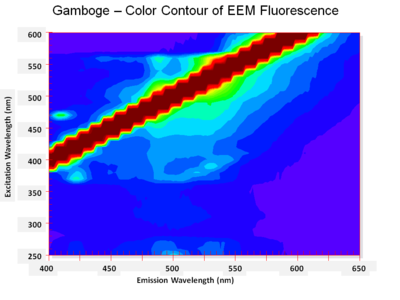Difference between revisions of "Category:Gamboge: Ukiyo-e colorant"
(Created page with "== Description == Sappanwood (suo): in progress <gallery> Sappsnwood trees.JPG|Sappanwood (''Caesalpinia sappan'') File:brazilwood raw.jpg|Cut pieces of brazilwood...") |
|||
| (48 intermediate revisions by 2 users not shown) | |||
| Line 1: | Line 1: | ||
| − | |||
| − | [[ | + | [[File:SC206496.jpg|right|400px|link=Masanobu, Perspective Picture of a Triptych of the Three Evening Poems, by the Authentic Originator of Color Printing and Perspective Prints, 11.13344|Perspective Picture of a Triptych of the Three Evening Poems by Okumura Masanobu]] |
| + | |||
| + | <font size="3">'''[[Gamboge]]'''</font> 藤黄 (''tōō''): A yellow-orange gum resin produced by several species of ''Garcinia'' tree found in South Asia (e.g. ''Garcinia morella'') and Southeast Asia (e.g. ''Garcinia hanburyi''). Gamboge was used as a yellow pigment as early as the 8th century in Asia and Japan. Gamboge is composed of a yellow resinous component (70-80%; morelloflavone) and a clear water-soluble [[Gum|gum]] (20%). Gamboge is obtained by scoring the trunks of trees of at least ten years of age in order to let the poisonous milky yellow resin drip into hollow bamboo canes. Once the resin has congealed, the bamboo is roasted over fire to evaporate remaining moisture. Then the bamboo it broken away to reveal rods of raw gamboge, which are then pulverized. Once pulverized, the color of gamboge is transformed from a dull to bright yellow. | ||
| + | |||
| + | Gamboge produces a transparent yellow which was frequently hand-painted on prints dating from the1690s to the 1740s. After the introduction of full color printing, its use seems to decline perhaps because the other yellows were easier to obtain and/or print and mix with other colorants. | ||
| + | |||
| + | '''For additional information see:''' [[Gamboge]], Uemura Dye Archive: [[Touou/Kusashiō (Gamboge) - left (195 L)|Gamboge 195]], [https://powo.science.kew.org/taxon/urn:lsid:ipni.org:names:427987-1 ''Garcinia hanburyi'' (Kew)], [https://powo.science.kew.org/taxon/urn:lsid:ipni.org:names:3285297-4 ''Garcinia morella'' (Kew)] | ||
| + | <br> | ||
| + | <br> | ||
| + | |||
| + | == Examples of Gamboge in Ukiyo-e Prints == | ||
| + | |||
| + | {|class="wikitable" style="display: inline-table;font-size:90%;text-align:center;width:15%" | ||
| + | |[[File:dyed indigo.jpg|200px]] | ||
| + | |- | ||
| + | | | ||
| + | [[File:Indigo FORS.JPG|200px]]<br>[[Harunobu, Beautiful Women of the Yoshiwara, Applying makeup (MFA 2006.1537.5)|Beauties of the Yoshiwara by Suzuki Harunobu]] | ||
| + | |} | ||
| + | {| class="wikitable" style="display: inline-table;font-size:90%;text-align:center;width:15%" | ||
| + | |[[File:dyed indigo.jpg|200px]] | ||
| + | |- | ||
| + | | | ||
| + | [[File:Indigo FORS.JPG|200px]]<br>[[Harunobu, Beautiful Women of the Yoshiwara, Applying makeup (MFA 2006.1537.5)|Beauties of the Yoshiwara by Suzuki Harunobu]] | ||
| + | |} | ||
| + | {| class="wikitable" style="display: inline-table;font-size:90%;text-align:center;width:15%" | ||
| + | |[[File:dyed indigo.jpg|200px]] | ||
| + | |- | ||
| + | | | ||
| + | [[File:Indigo FORS.JPG|200px]]<br>[[Harunobu, Beautiful Women of the Yoshiwara, Applying makeup (MFA 2006.1537.5)|Beauties of the Yoshiwara by Suzuki Harunobu]] | ||
| + | |} | ||
| + | {| class="wikitable" style="display: inline-table;font-size:90%;text-align:center;width:15%" | ||
| + | |[[File:dyed indigo.jpg|200px]] | ||
| + | |- | ||
| + | | | ||
| + | [[File:Indigo FORS.JPG|200px]]<br>[[Harunobu, Beautiful Women of the Yoshiwara, Applying makeup (MFA 2006.1537.5)|Beauties of the Yoshiwara by Suzuki Harunobu]] | ||
| + | |} | ||
| + | {| class="wikitable" style="display: inline-table;font-size:90%;text-align:center;width:15%" | ||
| + | |[[File:dyed indigo.jpg|200px]] | ||
| + | |- | ||
| + | | | ||
| + | [[File:Indigo FORS.JPG|200px]]<br>[[Harunobu, Beautiful Women of the Yoshiwara, Applying makeup (MFA 2006.1537.5)|Beauties of the Yoshiwara by Suzuki Harunobu]] | ||
| + | |} | ||
| + | |||
| + | == Analysis == | ||
| + | Gamboge does not fluoresce under UVA radiation and does not produce a distinct pattern using Excitation Emission Matrix (EEM) spectroscopy. This, in itself is unique because of the possible yellow colorants analyzed, it is the only bright yellow colorant that not only does not fluoresce but also absorbs the fluorescence emitted by the paper. This negative indication can be sometimes used to assign the presence of gamboge. | ||
| + | <gallery mode="packed" heights="200px" style="text-align:left;"> | ||
| + | Gamboge color.PNG|<center>3D EEM plot of Gamboge</center> | ||
| + | </gallery> | ||
| + | |||
| + | ==Images of Gamboge== | ||
<gallery> | <gallery> | ||
| − | + | File:Garcmore_03.jpg|''Garcinia morella'', <small>by India Biodiversity Portal</small>|link=https://indiabiodiversity.org/species/show/12281 | |
| − | File: | + | File:gamboge_pieces_1.jpg|Gamboge pieces |
| − | File: | + | File:Gamboge.jpg|Gamboge pieces |
| − | File: | + | File:296 gamboge.jpg|Gamboge powder |
| − | File: | + | File:Gamboge C100x.jpg|Gamboge at 100x |
| − | + | File:15_Powd_gamboge_200X.jpg|Gamboge at 200x | |
| + | File:gamboge_dyed paper.jpg|Paper dyed with gamboge | ||
| + | File:Printed gamboge-cropped.jpg|Printed gamboge | ||
</gallery> | </gallery> | ||
| − | == | + | ==List of Prints == |
| − | + | Below is a list of prints where gamboge was detected. | |
| − | |||
Revision as of 17:26, 21 April 2024
Gamboge 藤黄 (tōō): A yellow-orange gum resin produced by several species of Garcinia tree found in South Asia (e.g. Garcinia morella) and Southeast Asia (e.g. Garcinia hanburyi). Gamboge was used as a yellow pigment as early as the 8th century in Asia and Japan. Gamboge is composed of a yellow resinous component (70-80%; morelloflavone) and a clear water-soluble Gum (20%). Gamboge is obtained by scoring the trunks of trees of at least ten years of age in order to let the poisonous milky yellow resin drip into hollow bamboo canes. Once the resin has congealed, the bamboo is roasted over fire to evaporate remaining moisture. Then the bamboo it broken away to reveal rods of raw gamboge, which are then pulverized. Once pulverized, the color of gamboge is transformed from a dull to bright yellow.
Gamboge produces a transparent yellow which was frequently hand-painted on prints dating from the1690s to the 1740s. After the introduction of full color printing, its use seems to decline perhaps because the other yellows were easier to obtain and/or print and mix with other colorants.
For additional information see: Gamboge, Uemura Dye Archive: Gamboge 195, Garcinia hanburyi (Kew), Garcinia morella (Kew)
Examples of Gamboge in Ukiyo-e Prints

|

|

|

|

|
Analysis
Gamboge does not fluoresce under UVA radiation and does not produce a distinct pattern using Excitation Emission Matrix (EEM) spectroscopy. This, in itself is unique because of the possible yellow colorants analyzed, it is the only bright yellow colorant that not only does not fluoresce but also absorbs the fluorescence emitted by the paper. This negative indication can be sometimes used to assign the presence of gamboge.
Images of Gamboge
List of Prints
Below is a list of prints where gamboge was detected.
Pages in category "Gamboge: Ukiyo-e colorant"
The following 12 pages are in this category, out of 12 total.
G
K
- Kiyomasu I, Courtesan Reading a Poem, 28.198
- Kiyomasu II, Actor Ogino Izaburô I as Yamagami Gennai, Acting in the Aragoto Style with the Sumikazura Wig, 11.13297
- Kiyomasu II, Actors Segawa Kikunojô I as Yomogiu, Ichikawa Ebizô II as Tono no Hyôe, and Yamamoto Kyôzô as Kureha, 21.5459
- Komatsuken, Courtesan Parading with Two Kamuro, 11.19711
- Komatsuken, Young Man as the Bodhisattva Monju, 11.30137
- Komatsuken, Young Woman as the Bodhisattva Fugen, 11.30136










